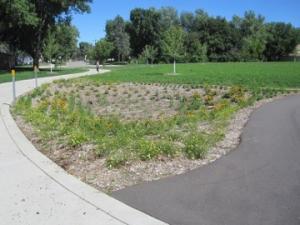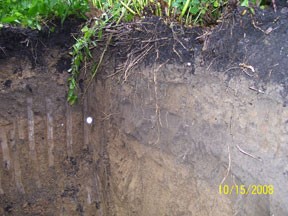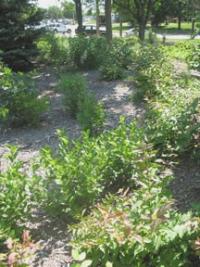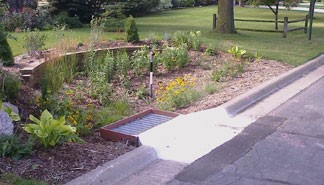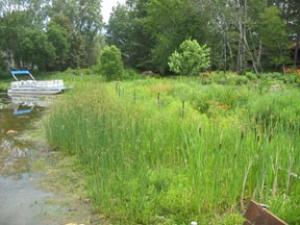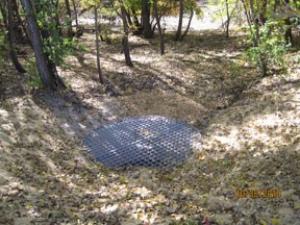What's Working for Conservation
Stormwater and Green Infrastructure Projects
Grass Matrix: When designing rain gardens and other native plantings, I draw inspiration from the beautiful and resilient native prairies by planting a framework of grasses or sedges across most of the planting area and then intermingling flowers within this framework (this is sometimes called a meadow garden, matrix planting, or interplanting). It is not an imitation of the prairie but is influenced by some of its most valuable characteristics: weed resistance and high infiltration due to a complete mat of grass roots occupying the upper 4’ of the soil profile, high pollinator and aesthetic values from the flowers, and a sense of tranquility and familiarity resulting from the continuous cover of grasses and grass-like plants. This groundcover of green grasses or sedges also helps native plantings blend aesthetically into our modern monocultured landscapes and lawns, unlike the traditional paint-by-numbers garden designs which often appear disjointed with their abrupt borders and glaring gaps between or within flower masses. To create a framework for matrix planting, use shorter grasses and sedges such as Prairie Dropseed, Side-Oats Grama, Little Bluestem, or Fox Sedge where flowers will be inter-planted. Create visual interest by also planting groups or single specimens of taller grasses or flowers such as Switchgrass or New England Aster. Space the framework of grasses and sedges about 30” apart so that when you interplant the flowers they will all be 15” apart. Some rhizomatous flowers, such as Prairie Coreopsis and Blue Flag Iris, can still be planted in masses to form more natural colonies. To view examples of meadow gardens and matrix planting, search for pictures of recent gardens designed by the famous garden designer Piet Oudolf or check out the Way Park rain gardens in Northfield, MN (Dustin Demmer, Freeborn County SWCD).
Root Depths: A recent USGS report http://pubs.usgs.gov/sir/2010/5077/ provides good information about prairie plant roots ability to penetrate clay soils. The accompanying photo shows the excavation pits they dug for this study, showing the root systems tapping into the dense silty clay. (Wade Johnson, Landscape Restoration Specialist).
Subsurface Treatment: St.Louis County has developed a video on subsurface water treatment systems: www.youtube.com/user/StLouisCountyMN
Engineered Soil: Using engineered soil in raingardens and biofiltration areas (70:30 sand:compost mix is commonly used) to improve infiltration (Rusty Schmidt, Washington Conservation District).
Containerized Plants: Using containerized plants to establish raingardens instead of seed to ensure rapid establishment and an ordered appearance (Rusty Schmidt, Washington Conservation District).
Soil Testing: Pre-testing work is important to analyze soils and the drainage area for a raingarden (Rusty Schmidt, Washington Conservation District).
Soil Compaction: Breaking up compacted soils (particularly in clay) can greatly increase infiltration rates for raingarden and bioretention systems (Rusty Schmidt, Washington Conservation District).
Watering: It is important to water planting (they should receive 1-inch per week) during the first year of establishment. The second year is less important unless conditions are very dry (Rusty Schmidt, Washington Conservation District).
Shrub Masses: Use shrubs in masses in raingardens and bioretention areas (pictured right) when little maintenance will be conducted can be effective to minimize weed competition (Gregg Thompson, Association of Metropolitan Soil and Water Conservation Districts).
Aggressive Species in the Base of Raingardens: Using aggressive rhizomatous species (sweet grass, prairie cord grass, lake sedge, river bank sedge (Carex emoryi) in the base of swales and bioretention areas can promote stormwater filtering while providing weed competition (Gregg Thompson, Association of Metropolitan Soil and Water Conservation Districts).
Pre-treatment: Anoka Soil and Water Conservation District has developed a curb-cut pretreatment box to prevent sediment from flowing into rain gardens (pictured left).
Woody Vegetation: It is beneficial to have woody vegetation in raingardens (dogwoods, viburnum, winterberry, chokeberry etc.) to decrease maintenance and add winter interest (Tim Olson, University of Minnesota, Facilities Management).
Turf Buffer: Turf can sometimes be problematic as a buffer strip as it can increase maintenance needs and can need repair if damaged (Tim Olson, University of Minnesota, Facilities Management ).
Chopping Dead Vegetation: Dead herbaceous vegetation can be chopped with a brush saw or sickle bar and be used as a mulch in raingardens in place of wood chips (Tim Olson, University of Minnesota Facilities Management).
Filling Bare Spots: Species such as blue and hoary vervain, black-eyed Susan, bergamot and giant hyssop can be seeded into bare spots in raingardens to create competition for weeds (Tim Olson, University of Minnesota Facilities Management).
Preventing Seed Movement: Planting the edge of detention basins or embankments in a way that will keep seed from moving downhill (seed drills, harrowing and packing the soil after broadcast or hydroseeding, use of erosion blankets).
Edging: Using edging around raingardens to prevent encroachment from Kentucky bluegrass.
Rows of Mulch: Using rows of mulch, edging or signage to control encroachment by lawn mowers.
Shelves in Retention Ponds: Creating shelves in retention basins (basins with open water) to create gently sloping areas and facilitate plant growth.
Emergent Plants: Planting emergent plants (river bulrush, sweet flag, giant bureed, lake sedge, broad-leaved arrowhead etc.) on the edge of open water and allowing them to grow into open water. These species can handle changing hydrology conditions and can aggressively compete with weeds (Dan Shaw, BWSR)
Watering: Watering plantings as needed to ensure good establishment.
Keeping Projects Off-line if Needed: If possible it is often beneficial to control stormwater flows within systems (diverting flows, retaining water away from establishing areas) until vegetation is several inches tall and can handle the hydrology.
Weed Management: Regular spot treatment or pulling of weeds is needed to prevent spread.
Shredded Hardwood Mulch: Using shredded hardwood mulch is preferred for raingardens as it is less prone to floating than other mulches.
Establishment Mowing: Mowing of upland plantings around detention areas during the first two years to around 6-8 inches to aid establishment of native prairie vegetation.
Sediment Removal: Routine removal of sediment to promote growth of vegetation.
Erosion Repair: Repair of erosion damage early (before it becomes a bigger problem) to assist vegetation establishment.
Urban Treatment: The RWMWD is collaborating with the owners of Maplewood Mall (Simon Properties), on a plan to provide stormwater treatment and volume reduction (infiltration) through the use of cisterns, rain gardens, and infiltration trenches with trees. In addition to substantially reducing runoff, this project will incorporate art and educational components as well. For more information, please visit: www.rwmwd.org/news (Bill Bartodziej, Ramsey-Washington Metro Watershed District).
Retrofits: Retrofits to Stormwater Pond as a cost-effective means of improved water quality. We are implementing retrofits in collaboration with the Anoka Conservation District for improved water quality in Sand Creek, a watershed that has a pre-stormwater treatment era build-out:
a. for increased storage and efficiency, we put in a new control structure at a higher elevation of 6-12” on an existing pond on school property.
b. Raising a pond outlet by one foot to infiltrate all runoff from a 2-inch rainfall, redirecting one of the two inlet pipes away from the outlet, and installing two sediment collection forebays at the two inlet pipes.
We also did some summer culvert-blocking in recent drought years: 2008 & 09 and found that very useful in keeping water in areas where the creek nearly ran dry. A video describing retrofit projects can be found at: http://www.youtube.com/watch?v=m69ft2ifMdw (Dawn Doering, Coon Creek Watershed District)

